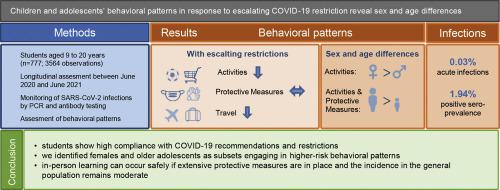Journal of Adolescent Health ( IF 7.6 ) Pub Date : 2021-11-24 , DOI: 10.1016/j.jadohealth.2021.11.021 Mira Paulsen 1 , Anna Zychlinsky Scharff 2 , Kristof de Cassan 3 , Rizky Indrameikha Sugianto 1 , Cornelia Blume 4 , Holger Blume 5 , Martin Christmann 6 , Corinna Hauß 7 , Thomas Illig 8 , Rebecca Jonczyk 4 , Norman Klopp 8 , Verena Kopfnagel 8 , Ralf Lichtinghagen 6 , Henning Lucas 9 , Anke Luhr 10 , Frauke Mutschler 1 , Thomas Pietschmann 11 , Philipp-Cornelius Pott 3 , Jana Prokein 8 , Paula Schaefer 3 , Frank Stahl 4 , Nils Stanislawski 5 , Jeannine von der Born 1 , Bernhard M W Schmidt 12 , Stefanie Heiden 9 , Meike Stiesch 3 , Nima Memaran 1 , Anette Melk 1

|
Purpose
The COVID-19 pandemic affects students in a myriad of different ways. Our prospective, longitudinal study in a cohort of students in Hannover, Germany explores behavioral patterns during escalating COVID-19 restrictions.
Methods
In total, 777 students between the age of 9 and 20 were assessed for their activity engagement, travel patterns, and self-assessed compliance with protective recommendations at six time points between June 2020 and June 2021 (3,564 observations) and were monitored for severe acute respiratory syndrome coronavirus 2 infection by nasal swab polymerase chain reaction and serum antibody titers.
Results
Activity engagement decreased, but self-assessed compliance with measures such as mask wearing and social distancing was stable during escalating restrictions. Although we found no sex difference during the summer break, when incidence was lowest, females engaged in a higher variety of activities than males for all other time points. Older students engaged in more activities and self-assigned themselves lower compliance values than younger ones. Greater involvement in different activities was seen in households which traveled more frequently. Infection rate in our cohort was low (0.03% acute infections, 1.94% positive seroprevalence).
Discussion
Our study supports the view that, overall, students show high compliance with COVID-19 recommendations and restrictions. The identification of subsets, such as female and older students, with higher risk behavioral patterns should be considered when implementing public information campaigns. In light of the low infection rate in our cohort, we conclude that in-person learning can occur safely if extensive protective measures are in place and the incidence in the general population remains moderate.
中文翻译:

儿童和青少年应对不断升级的 COVID-19 限制的行为模式揭示了性别和年龄差异
目的
COVID-19 大流行以多种不同方式影响学生。我们在德国汉诺威的一群学生中进行的前瞻性纵向研究探索了 COVID-19 限制升级期间的行为模式。
方法
在 2020 年 6 月至 2021 年 6 月之间的六个时间点(3,564 次观察),总共对 777 名 9 至 20 岁的学生进行了活动参与、旅行模式和自我评估对保护建议的遵守情况(3,564 次观察),并接受了严重急性鼻拭子聚合酶链反应和血清抗体滴度的呼吸综合征冠状病毒 2 感染。
结果
活动参与度下降,但在限制升级期间,自我评估对戴口罩和保持社交距离等措施的遵守情况保持稳定。虽然我们在暑假期间没有发现性别差异,但在发病率最低的时候,女性在所有其他时间点从事的活动种类多于男性。与年轻学生相比,年龄较大的学生参与的活动更多,并给自己分配了更低的合规值。在旅行更频繁的家庭中,人们对不同活动的参与程度更高。我们队列中的感染率很低(0.03% 的急性感染,1.94% 的阳性血清阳性率)。
讨论
我们的研究支持这样一种观点,即总体而言,学生对 COVID-19 建议和限制的遵守程度很高。在实施公共信息运动时,应考虑识别具有较高风险行为模式的子集,例如女性和年龄较大的学生。鉴于我们队列中的低感染率,我们得出结论,如果采取广泛的保护措施并且普通人群的发病率保持适中,则可以安全地进行面对面学习。



























 京公网安备 11010802027423号
京公网安备 11010802027423号